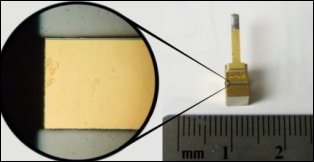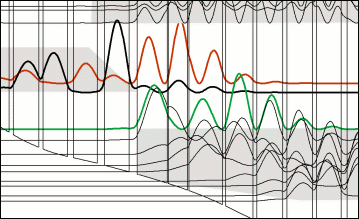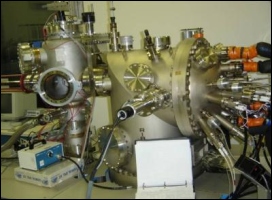Quantum Cascade Laser Research Overview
Terahertz Quantum Cascade Lasers (QCL's) consist of a sequence of fine-tuned quantum wells that create quantized electron states within the conduction band. Transitions between these subband states allows for lasing at energies much lower than traditional lasers can offer.
What is a QCL?
A Quantum Cascade Laser (QCL) is a next-generation device that uses electron transitions between man-made quantum well levels, as opposed to traditional lasers that use transitions between atomic levels. A QCL is built by stacking up alternating layers of semiconductors with thicknesses of only a few atoms. High precision of the layer widths and high purity of the semiconductor materials is required in order for the laser to work. A bias voltage is applied to the laser to slant the quantum well landscape and creating the cascading structure.
How does a QCL work?
The alternating layers of semiconductor materials create a set of energy wells in the conduction band edge profile. The wells trap electrons in the one dimension that the materials vary. The wells are narrow enough that the electron's form stationary quantum states that extend over several wells. When the bias voltage is applied, the electrons feel a force pushing them down the cascade structure. The electrons jump from one quantum state to the next, usually emitting a phonon (a crystal vibration that becomes heat) or giving energy to other electrons. By properly adjusting the layer thicknesses, the quantum states are fine-tuned so that it becomes more probable at a certain transition for the electron to emit a photon than anything else. The electrons cascade down through the quantum states like a waterfall, emitting laser radiation at each drop.
Why Terahertz?
Terahertz (THz) radiation is used in the military for radar imaging of scaled targets. Instead of taking radar signatures of full-scale vehicles with radar antennas, accurate scale-models of the vehicles are built. The frequency of the radar must also be scaled in order to be used with the scale models and give the correct scattering physics. As a result, sub-millimeter and terahertz radiation sources are necessary to provide the scaled frequencies. Currently, expensive gas lasers that fill a whole room must be used to generate THz radiation. QCL's are much more compact and potentially cheaper at providing THz radiation.
QCL Code Prediction
Dr. Baird is the head of the QCL code prediction team at West Texas A&M University. Our QCL code was designed from the first principles of quantum theory in order to accurately predict QCL performance. The user specifies the layer materials, their thicknesses, their doping, the temperature, and the bias voltage. The code then constructs the conduction band edge profile and calculates the number of free electrons. After self-consistently solving the Schroedinger-Poisson equation, scattering calculations, and rate equations, the code provides a plot of the band-edge profile, the quantum states, the laser frequency spectrum, and the laser power emitted.
Read more about QCL theory.





